
Cladorhiza is a genus of carnivorous sponges, comprising around 40 species found in oceans around the world. Cladorhiza is the type genus of the family Cladorhizidae.
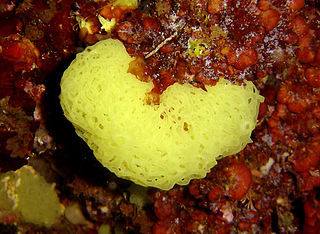
Clathrina is a genus of calcareous sponge in the family Clathrinidae. Several species formerly in Clathrina were transferred to the newly erected genera Arturia, Ernstia, Borojevia, and Brattegardia in 2013. The name is derived from the Latin word "clathratus" meaning "latticed".
Levinellidae is a family of calcareous sponges in the order Clathrinida. It contains the following genera and species:
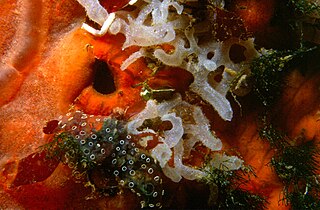
Leucosolenia is a genus of calcareous sponges belonging to the family Leucosoleniidae. Species of this genus usually appear as groups of curved vases, up to 2 cm long, each ending in an osculum. The overall shape is sometimes likened to a tiny bunch of bananas. They are most often observed in tide pools, clustered around the base of seaweeds or on rocks, and occur in a variety of colours, usually rather pale. Its canal system is of asconoid type. The colony consists of few simple vase-like, cylindrical individuals each terminating in an osculum and united at their bases by irregular horizontal tubes. Leucosolenia reproduces both asexually and sexually. asexual reproduction by budding and sexual reproduction takes place by formation of gametes, i.e., ova and sperms. Lecosolenia is hermaphrodite, because both the gametes are formed in the body of same individual. Sponges are mostly asymmetrical, but Leucosolenia is symmetrical.

Grantia is a genus of calcareous sponges belonging to the family Grantiidae. Species of the genus Grantia contain spicules and spongin fibers.
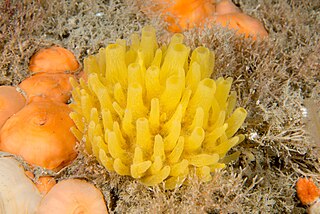
Polymastia is a genus of sea sponges containing about 30 species. These are small to large encrusting or dome-shaped sponges with a smooth surface having many teat-shaped projections (papillae). In areas of strong wave action, this genus does not grow the teat structures, but instead grows in a corrugated form.

Halichondria is a genus of sea sponges belonging to the family Halichondriidae. These are massive, amorphous sponges with clearly separated inner and outer skeletons consisting of bundles of spicules arranged in a seemingly random pattern.
Ascaltis pelliculata is a species of sea sponge in the family Leucascidae, first described as Leucoselenia pelliculata by Arthur Dendy in 1891. it is found in the coastal waters of Victoria.
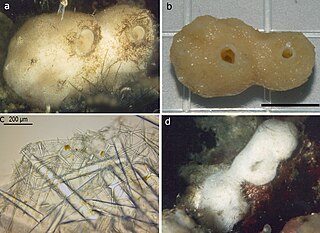
Leucandra is a genus of calcareous sponge belonging to the family Grantiidae. Its earliest known fossils are from the Jurassic.
Leucopsila is a genus of poriferans in the family Baeriidae. It contains one species, Leucopsila stylifera, which was originally described as Leuconia stylifera in 1870. The genus was described by Dendy & Row in 1913.

Sycon is a genus of calcareous sponges belonging to the family Sycettidae. These sponges are small, growing up to 7.5 cm with a length from 2.5 to 7.5 cm, and are tube-shaped and often white to cream in colour. They are known to aquarium hobbyists as "Pineapple" or "Q-Tip" sponges, and are frequent "hitchhikers" accidentally brought in.

Arturia is a genus of calcareous sponge in the family Clathrinidae which contains 14 species. It is named after Arthur Dendy, a prominent researcher of calcareous sponges. It was renamed Arturia in 2017 because the name Arthuria was already assigned to a genus of molluscs.

Rossellidae is a family of glass sponges belonging to the order Lyssacinosa. The family has a cosmopolitan distribution and is found at a large range of depths.
Amphoriscus is a genus of calcareous sponges in the family Amphoriscidae.

Soleneiscus is a genus of calcareous sponges in the family Dendyidae.
Ascaltis grisea is a species of sea sponge in the family Leucascidae, first described as Leucosolenia grisea by Arthur Dendy in 1891. It is known only from its type locality on the Houtman Albrolhos archipelago in Western Australia. It is a marine sessile filter-feeder.

Leucetta is a genus of sponges in the family Leucettidae, which was first described in 1872 by Ernst Haeckel. The type species is Leucetta primigenia Haeckel, 1872 by subsequent designation.
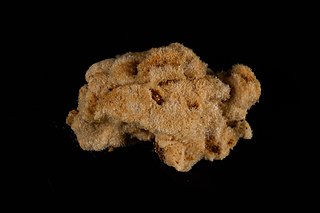
Leucettusa is a genus of sponges belonging to the family Leucaltidae. The species of this genus are mostly known from the Arctic and Antarctic, New Zealand and Southwest Australia.
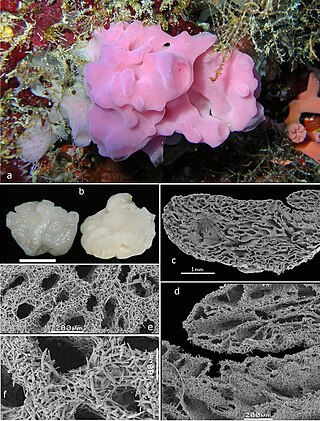
Leucascus is a genus of sponges belonging to the family Leucascidae.













